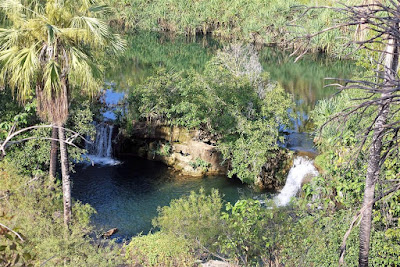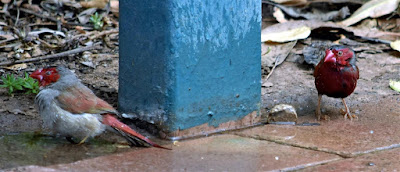28 – September 2016 - 28/9/16
Departing Lawn Hill National Park under the threat of rain,
we had about 100 kilometres of dirt roads to negotiate to the nearest bitumen surfaced
road. The road wasn’t too bad other than a few areas already looking like a
quagmire in places created by passing vehicles. The composite of the dirt roads
in this area become very slippery and boggy when wet, making travel a dangerous
affair, especially so when towing a caravan.
We spent the night near the side of the road where we had
located a good gravelled surface with plenty of gravel piles about. It looked
like it was being set up for the manufacture of bitumen to resurface nearby sections
of the road. It rained during the night and we were so glad we had made the
decision to leave Lawn Hill when we did.
Due to water lying in plenty of hollow dips on the bitumen
road surface there was an increased presence of animals on the road having a
drink of water.
Over about 4 hours of driving we narrowly avoided coming
into contact with more animals than we had over all our years of travel. It was
probably the most rainfall we had experienced over the last 5 months.
With our vehicle brakes fully applied, a Bustard Bird flew
across our bonnet within millimetres of striking our windscreen, an emu changed
direction within a metre of striking us, we had so many near misses with
kangaroos, one dove bird didn’t make it with a finale viewing from our side
rear view mirror of many summersaults disappearing into a cloud of feathers, there
were plenty of cattle along the roads edge with a few horses and we were saved
again when we slowed approaching some road kill on the road when all of a
sudden an eagle flew up travelling straight across in front of us. It was a
tiring day of driving with extra concentration required. Yes the roads seemed
to have a higher concentration of road kill about (dead animals) than we had
seen for a long time.
At Normanton we booked into a caravan park for a couple of
nights, awaiting an assessment of the weather conditions and predictions before
deciding on an appropriate safe travel plan. We slipped on our walking footwear
and spent a couple of enjoyable hours wandering around Normanton, viewing
plenty of magnificent buildings and its setting.
We drove to Karumba for a day about 70 kilometres north of
Normanton. Karumba is primarily a fishing village located at the mouth of
Norman River and the Gulf of Carpentaria. It boasts four caravan parks and two
modern boat launching facilities with all the required shops and food available
that we seem to rely upon these days including a bakery. We did sample some
naughty bakery items along with fish and chips for lunch.
At Karumba we visited the Barramundi Discovery Centre a
Barramundi hatchery which produced 120,000 fingerlings the previous year. We
participated in the Barra feeding and found the provided information quite
interesting.
Karumba was an interesting place to visit for a day trip but
without any other attractions other than fishing we doubt we would be tempted
to visit this location again.
On the Norman River near the outskirts of Normanton you were
permitted to free camp for a maximum of 2 nights if you had a self-sufficient/self-contained
vehicle and a council permit. We obtained a permit from the information centre
and of note the council ranger regularly checked the camping area whilst we
were there.
It had been 15 days since our last food shop. There were two
smallish supermarkets at Normanton and we heard about a fresh fruit &
vegetable truck that attends Normanton on Wednesdays at 3 pm for one hour at
the Albion Pub carpark. We purchased all our fruit and vegetables from this
truck, which were of superior quality to what was available in the shops.
Travelling east from Normanton we were hoping to be at a
road side stop called Black Bull Siding when the heritage listed Gulflander
train stopped for morning tea. Fortuitously we became aware that we wouldn’t
arrive in time, and then luckily we found a roadside stop alongside the rail
line where we hoped to see the train pass on its way to Normanton.
It makes you feel good when a hypothetical plan comes
together. Twenty minutes later the Gulflander train appeared around the bend
and on seeing us the train driver honked the train horn a few times and the
passengers including the driver all merrily waved at us as they travelled by.
A short time later we stopped at Black Bull Siding for an
inspection less the presence of the Gulflander Train.
If it had been a Wednesday we would have considered camping
the night at Black Bull Siding to welcome the Gulflander train on its return
trip from Croydon to Normanton but it was Thursday and the train wouldn’t be
travelling through this area until the following Wednesday so we decided to
continue east to Croydon.
Croydon was established by a mining boom in the late 18th
century which produced 23,675 kilograms of gold over 35 years. At its peak
there were 36 pubs at Croydon and now there is 1 which was up for sale.
Today Croydon relies on the cattle stations around the
district and tourism for its survival. There is a heritage precinct of 18th
century buildings and mining equipment displayed in town, all free entry to
attract tourism. We enjoyed a few hours walking around town followed by a swim
in the caravan park swimming pool, naturally which also included plenty of
chatting with other swimming pool patrons.
 |
| Not sure what she is thinking? |
 |
| Whatever she was thinking it ended with her being in court |
 |
| No not the wip |
 |
| Beautiful seating |
Queensland outback non-arterial roads consist mostly of dirt
surfaces and when you are lucky enough to obtain a bitumen surface quite often it
would be a single lane width of bitumen. When you came across a vehicle from
the opposite direction, generally, both vehicles drivers side would stay on the
bitumen with the passenger’s side moving off the bitumen onto the side
dirt/gravel surfaces. If speed is involved, vehicles can get struck by flying
rocks from the passing vehicle, creating a risk of windscreen and body damage.
We generally choose to stop with our rig off the bitumen to allow the oncoming
vehicle to pass us whilst still completely on the bitumen surface minimising the
chance of damage from flying rocks. The road surface we were travelling along
(Savannah Way) was mostly a single lane of bitumen with intermingled sections
of double laned bitumen.
Our next targeted location was Cumberland Chimney a roadside
stop about 20 kilometres west of Georgetown where an impressive looking 1889
built brick chimney and nearby dam with plenty of bird life are the main
remnants of the Cumberland Gold Mine. This was another beautiful free roadside
rest area with all new (2016) long drop loo, shelters with tables & seating
along with a sheltered viewing platform overlooking a large dam with quite a
variety of birds to be seen including a Jabiru, Magpie Geese and various ducks
at the time of our visit.
 |
| Sunrise |
The ambient air temperature over the last couple of weeks
had been hovering between 34–38 C, hindering human activities, other than
cooling off with a swim and consuming ice cream when available. There had been
a noticeable decline in the number of travellers about during the last 4 weeks,
even with school holidays happening during this time frame and we had been
enjoying the ‘quieter time’ with less people about.
Unfortunately the intense heat was starting to wear us down,
restricting our enjoyable activities and lessening the amount of time we were
spending at stopovers. We were now bypassing some nice looking camping areas
due to the heat and seeking out caravan parks to obtain air-conditioned
respite. Adding to our fatigue was the increased amount of travelling time,
where we had covered around a 1000 kilometres in the last week.
Leaving Cumberland Chimney we travelled to Georgetown where
we spent time viewing over a modern display of about 4500 gemstones and
minerals at the TerrEstrial Centre located in the information centre. Simply
put, it was amazing.
Our next stop was in a caravan park at Mt Surprise and yes
we did cool off in the swimming pool. We had only been without power for 3
nights but the air-conditioned caravan felt so good, rejuvenating our bodies from
the stifling heat for our next planned stop at the - Undara Lava Tubes; the
main reason for us being in this area of Queensland and another location we had
been desiring to tick off on our bucket list.
The campground at Undara Lava Tubes was set in a beautiful
bush setting. We were quite content walking through the bush along some of the
walking trails available from the campground.
At Undara you are only permitted to experience viewing the
lava tubes through a guided tour.
Most of Undara National Park is a “closed national park,”
due to hundreds of lava tubes (caves) scattered about the national park, most
unexplored. If someone wandered around in the national park and fell down an
unknown hole in the roof of a lava tube injuring themselves or unable to get
out, it would be highly probable that no one would know where they were or be
able to locate them. Thus for the safety of the public it is classified as a
closed national park.
Undara Volcanic National Park has one of earths longest lava
flows in modern geological time. We participated in the Archway Explorer tour
walking along boardwalk pathways through vast tunnels created by lava flow. It
was an awesome experience viewing the lava tubes. We were extremely satisfied
with this experience and very glad that we had made the effort to travel to
this location of Australia.
The whole presentation, including the setting, the various
levels of accommodation on offer, the restaurant, dining areas and
entertainment had been given a lot of thought producing a great locale in
cohesion with nature providing a very impressive set up.
We had heard this location was worth a visit but hadn’t been
given any description of what to expect. All the lava tubes were very dark and
unlit. The tour guide had a torch which they pointed up at the ceiling to
illuminate the walking platform. If you got disorientated you would hold onto
the handrail and walk towards the light at the tunnel entrance generally seen
in the distance. We would have liked to have taken a torch with us for not only
our personal viewing but to assist with photographs for something that the
camera could focus on to take a picture. Thus our below pictures showing the
lava tubes have only been illuminated by our cameras flash when the camera
thought there was enough light to focus on a given point.
On one of our trail walks we bumped into a bubbly couple for
the second time on a different track and we naturally stopped for a chat. They
had gotten so excited about their first lava tube experience that they had
managed to participate in all three lava tube viewings on offer on the same
day. Each one had been in a different tube with its own unique features but
generally speaking all were quite similar. This couple had flown from Sydney to
Cairns, hired a car, driven the 200 kilometres to Undara, stayed in the railway
carriage accommodation right next to the hub where all the activities are
located.
We were happily impressed with our Undara Lava Tube
experience and would recommend consideration for attending this location in
Australia to all.


































































































